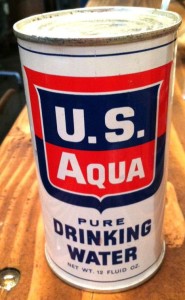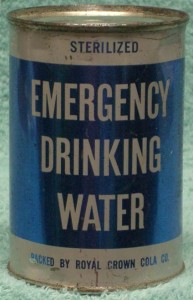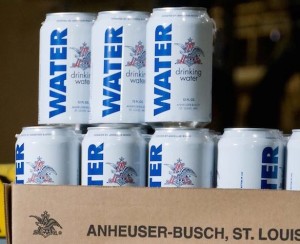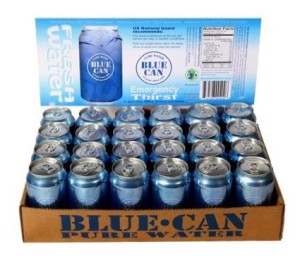Originally published at Notes From The Bunker. You can comment here or there.
It occurred to me that while I have plenty of posts about food and being able to shove more cake down your piehole, I dont have any posts about the other end of the gastrointestinal tract.
In many situations, when the power goes out the water pressure sometimes follows. Even if you’re in an area that is served by gravity, rather than pumps, all it takes is some physical disruption to the delivery system (damaged pipes, etc.) and turning on the taps gets you nothing but a gurgle and a feeling of impending doom.
Now, drinking water isn’t that big a deal compared to water for sanitation. We all store water, and a method to purify it, right? Worst comes to worst, we take our Katadyn and a five-gallon jug, have someone stand watch, and we pump some water from the nearby river or lake. Unfortunately, sanitation takes a bit more water than that.
The average flush toilet in this country uses something like 1.6 to 4 gallons of water depending on your toilet. If you’re good with a bucket you can ‘flush’ your toilet with a well-heaved bucket of water into the bowl. But let’s be real here….we’re guys – give us a shovel, a roll of toilet paper, and a modicum of privacy and we’ll be fine. We are, after all, the gender that has raised bodily function jokes into a social greeting and form of entertainment. Chicks, on the other hand, can get a little fussy about this sort of thing. Don’t think so? Try to remember back to your dating days…what was the one thing that chicks weren’t willing to put up with in your bachelor pad? Filthy bathroom. Your kitchen could look like a food-decay laboratory, and she might think the 48″ metal lathe in the living room was ‘manly’, and she might even tolerate the sheets that crunched when you lay down on them, but if the toilet in your bathroom looked like a Third World squathole you may as well forget about any sort of action.
More than aesthetics and squeamishness, the improper handling/disposal of…uhm….’waste’…is a major health risk. When there’s a huge disaster just about anywhere in the world what follows about a week later? Cholera, typhoid, dysentery and a host of other serious diseases related to ‘improper hygiene and sanitation’. The classic example is Typhoid Mary who, through her career as a cook, managed to kill and sicken quite a few people before she was forcibly isolated for the public good.
Solution? Well, you know that old saying about not crapping where you sleep? That and some serious attention paid to handwashing and cleanliness will go a long way. But, more importantly, when the water-flush porcelain commode becomes an artifact of a happier, less apocalyptic time, a Plan B is going to be needed.
Fortunately, there are some options. (Although none are as familiar as what we’re used to.)
There are all sorts of ‘portable toilet’ systems out there. All are pretty much the same thing – some type of toilet-seat situated over a removable plastic bag. That’s pretty much the basic design. After that, it’s bells and whistles. Some systems use a powder or other medium to reduce odors and turn liquids to solids, some use heavy deodorizers, and some are about as simple as you can get. (Like the guys overseas who improvise toilet seats out of their tri-fold shovels.)
The old Civil Defense sanitation kits are probably the forerunners to what we see today in terms of products like this and this. The old CD kits might be a good foundation to use in designing your own kit. I suppose in an emergency just about any suitable container, such as a garbage can, and a pile of plastic bags can be improvised into use as a portable toilet but why improvise when you can get something a little more purposeful? And although this seems like some sort of redneck joke, I can see where might be pretty practical at a hunting camp or similar venue.
and this. The old CD kits might be a good foundation to use in designing your own kit. I suppose in an emergency just about any suitable container, such as a garbage can, and a pile of plastic bags can be improvised into use as a portable toilet but why improvise when you can get something a little more purposeful? And although this seems like some sort of redneck joke, I can see where might be pretty practical at a hunting camp or similar venue.
Regardless, in addition to a toilet seat and some sort of catchment, there appears to be some other things that will go along with them to make things a lot easier and safer. The old CD sanitation kits packed:
Sanitation Kit Contents List
|
Kit Item
|
SKIII
|
SKIV
|
| Commode Seat, Plastic |
1
|
1
|
| Can Opener (manual) |
1
|
1
|
| Sanitary Napkins |
36
|
60
|
| Hand Cleaner (can) |
1
|
1
|
| Polyethelene Gloves (pair) |
1
|
1
|
| Water Dispensing Spout |
1
|
1
|
| Tie Wire (bag closing) |
1
|
1
|
| Cups and Lids (plastic) |
35
|
70
|
| Commode Chemical (pack) |
6
|
12
|
| Poly Bag Liners (commode) |
1
|
1
|
| Instruction Sheet |
1
|
1
|
| Toilet Tissue |
5
|
10
|
If I had to guess, and I do, I’d say the cups and lids were for the gents to use in a quiet corner of the shelter. No point in filling that commode any faster than necessary, right?
So lets say you’ve purchased some sort of portable toilet system. What should be packed away with it? Well, right off the top, you’re probably not going to ever find that you can have too many plastic receptacle bags. Really. Go long on these. Next item up is the future currency in just about any disaster – toilet paper. Again, having too much is pretty impossible. How much to have? Just keep buying it and stocking it away. Make sure you protect it from wet (obviously) and from critters that like using it as nesting material. After that, I’d think you’d want a large amount of hand sanitizer/cleaner/soap, a few gallons of bleach and a spray bottle, maybe some Lysol spray, gloves for handling clean up, some method of sealing the bags, and a few other sundries..(like a shovel for burying the bags). Given the critical nature of a piece of equipment like a small portable toilet it may be a good idea to have more than one. Given the relatively low price of some of these packages, it might be a bit more comforting for each person to have their own.
Unfortunately, in large natural disasters like Katrina, Haiti, Japan, etc. it seems that cholera and associated diseases spring up immediately afterwards. While you can’t do much about other folks’ behaviors, you can certainly minimize risks to yourself – wash your hands thoroughly and frequently, especially after bathroom breaks. Disinfect the hell out of anything that is used communaly by anyone for anything..toilet seats, door knobs, radio handsets, bicycle handlebars, etc, etc. And have a plan and supplies in place so that when the water supply or sewage elimination options dwindle to nothing you can still manage with a degree of safety and cleanliness.
=-=-=-=-=-=-=-=-=-=
The blegging continues for another couple days.








